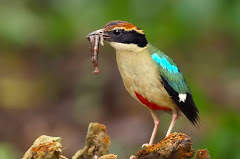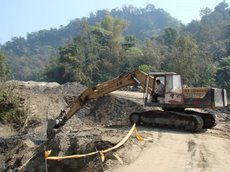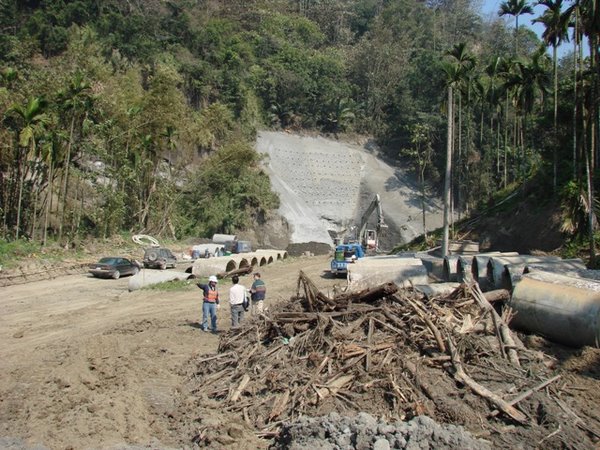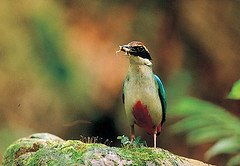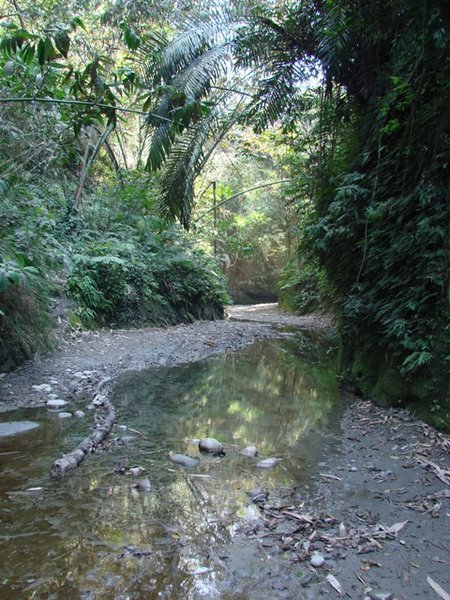 A Huben Fairy Pitta (Pitta nympha): photo courtesy of Richard Yu.
A Huben Fairy Pitta (Pitta nympha): photo courtesy of Richard Yu.
Happy New Year and all the best for 2010 !
"Because every green measure, every conservation effort and all the little economies we could make in our daily lives, may look insignificant if we choose to look at the big picture. On the other hand, if we view that big picture as millions of little choices made by people just like us, that's how we can come to understand why it's our own choices that are so important."
A comment posted on Birdforum by James Owen.
Thursday, December 31, 2009
Happy New Year !
Posted by
Wild at Heart Legal Defense Association
at
3:31 PM
0
comments
![]()
Tuesday, December 29, 2009
FTV report on high levels of cancer in Mailiao and Taisi Townships in Yunlin County
What follows is an English translation from part 2 of a series that Formosa TV (FTV) has done on the high cancer rate from the areas surrounding the Formosa Petrochemicals’ No.6 Naphtha Cracker plant at Mailiao on the Yunlin County coast in central Taiwan.
As planned expansion of heavy industry in this area goes ahead it will no doubt cause an increase in these cancer rates as emission levels increase dramatically. The government is forging ahead with its so-called development plans. In November the Taiwan Environmental Protection Administration gave the green light to the planned Erlin Science Park just over the county border in Changhua county. Demands for water for heavy industry will be supplied by the infamous Hushan Reservoir project. It would seem that the health of the citizens of central Taiwan, both human and non human, come a very poor second when it comes to keeping heavy industry happy. Spare a thought for the Fairy Pitta and Taiwan White Dolphins in all this mess.
Naphtha cracking plant linked to high cancer rate in central Taiwan towns (2009/12/27)
The central Taiwan townships of Mailiao and Taishee have had the highest liver cancer death rates of any area in Taiwan for years. Nearby is Taiwan’s largest naphtha cracking plant. The Yunlin County government commissioned an NTU professor to conduct research on the health risks posed to the residents of areas around the plant. Tonight, in part 2 of a continuing series, we take a closer look at the research report.
This thick research report helped open the scientific discussion related to Formosa Petrochemicals’ No. 6 Naphtha Cracker and local residents’ health. National Taiwan University Professor Jhan Jhang-cyuan spent one year gathering information from the five neighboring townships of Mailiao, Lunbei, Taishee, Dongshih and Shihu. The report was commissioned by the Yunlin County government. It compiled information from the Department of Health, Ministry of the Interior and Bureau of National Health Insurance. The results showed an important discovery.
Jhan Jhang-cyuan
National Taiwan University
If you look at the death rates from malignant tumors and lung cancer in Taishee Township from the fourth to the sixth year of operations, they’re obviously higher than the first three years. So the longer operations have been going on, the higher the rate of cancers in Taishee Township, particularly lung cancer. The rate of liver cancer in Taishee and Mailiao townships both before and during the operation period is higher than other townships we looked at. So it’s correct to say that the rates of liver and other types of cancers are high in Yunlin County, but since the No. 6 Naphtha Cracker they’ve become even higher.
The petrochemicals industry possesses many cancer-causing agents. Among them is vinyl chloride monomer, which is a raw material for plastic and has been connected to liver cancer. The oil refining process produces byproducts such as benzene and acetic acid that have been shown to be related to leukemia.
Petrochemical plants often emit polycyclic aromatic hydrocarbons, which are known to be closely associated with lung cancer. Professor Jhan also examined air quality reports from the Environmental Protection Administration and data from the Bureau of National Health Insurance. He discovered that more people were hospitalized for breathing difficulties when emission levels of nitrogen oxide, sulfur dioxide and other similar gases were high. There were also more deaths.
Jhan Jhang-cyuan
National Taiwan University
Monitoring was performed every hour of every day for two years. The data was then applied to Taishee. It obviously showed that when the wind blew from between the northwest and northeast, (gas) concentrations would become very high. They could increase from 20 to 30 times or more above average.
These scientific discoveries were completely in line with the experience of local residents. When the wind blew or the rain fell, their crops would suffer.
Mr. Chen
Erlun Township Farmer
These (melons) can’t be harvested. It only needs to rain once and they will turn yellow and start to rot. These melons won’t grow large, all of them here. It just needs to rain once and the pollution will kill them.
Crops like chrysanthemums will also begin to rot immediately after rainfall. The destruction of crops can be made up for by compensation payments, but human beings are a different matter. Although Erlun Township was not included in Jhan’s report, many of the same health issues are occurring there.
Erlun Township Resident
It might be factors such as the air or water, but we don’t have professional knowledge. If we blame the No. 6 Naphtha Cracker, they will tell us to bring forward our evidence.
Reporters who seek the company’s side of the story always have trouble receiving a direct answer.
Voice of Formosa Petrochemicals PR Rep.
Generally speaking, (there are many causes of cancer). For example, even if you live in mountains where the air is very good, some people still get cancer. We don’t know why.
Just when our investigation had seemed to reach an impasse, we acquired a copy of a survey from 2005 performed by the Industrial Development Bureau. The survey focused on the No. 6 Naphtha Cracker and the health risks of local residents. The report was marked “Restricted Reading.” It turned out that the bureau possessed relevant assessment reports years ago, but never made the results public. In our next installment we will take a look at the secrets inside the bureau’s report.
Source: http://englishnews.ftv.com.tw/read.aspx?sno=C585E7E31DEF7010ACF37A7BE56126CD
Posted by
Wild at Heart Legal Defense Association
at
3:19 PM
0
comments
![]()
Friday, December 11, 2009
Snowy-browed Flycatcher: New Bird for the Huben-Hushan IBA Bird List

 Male Snowy-browed Flycatcher (Ficedula hyperythra): Photos courtesy of Richard Yu.
Male Snowy-browed Flycatcher (Ficedula hyperythra): Photos courtesy of Richard Yu.
On Saturday 5TH December 2009 birders Mark Wilkie and Dr. Bruno Walther spotted a male Snowy-browed Flycatcher Ficedula hyperythra innexain the forest around Huben village. This is the first record of a Snowy-browed Flycatcher in the Huben-Hushan Important Bird Area (IBA). Snowy-browed Flycatcher is a resident species on Taiwan and usually found in mid to upper elevation forests (1000-2300m) but can sometimes be found at lower altitudes during winter. Race innexa is endemic to Taiwan.
Huben-Hushan Bird List
Posted by
Wild at Heart Legal Defense Association
at
11:37 AM
0
comments
![]()
